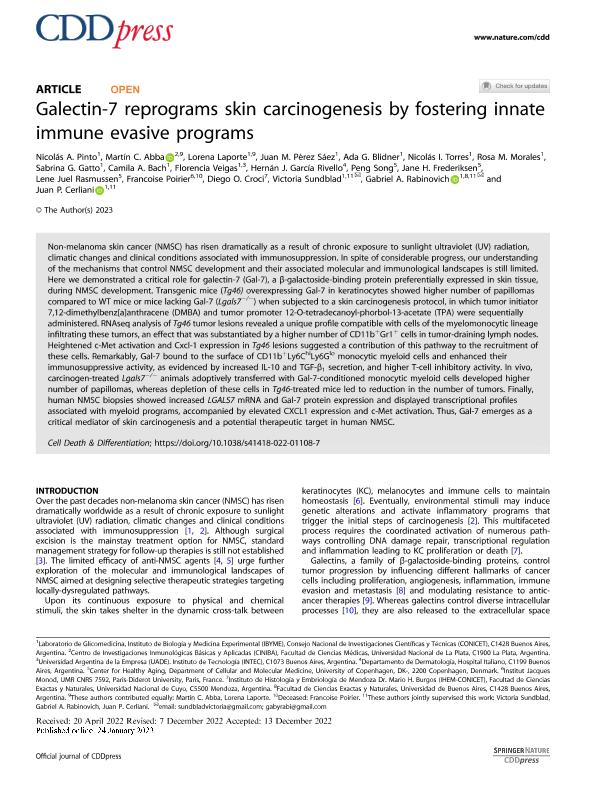Artículo
Galectin-7 reprograms skin carcinogenesis by fostering innate immune evasive programs
Pinto, Nicolás Alejandro ; Abba, Martín Carlos
; Abba, Martín Carlos ; Laporte, Lorena
; Laporte, Lorena ; Pérez Sáez, Juan Manuel
; Pérez Sáez, Juan Manuel ; Blidner, Ada Gabriela
; Blidner, Ada Gabriela ; Torres, Nicolás
; Torres, Nicolás ; Morales, Rosa María
; Morales, Rosa María ; Gatto, Sabrina Gisela
; Gatto, Sabrina Gisela ; Bach, Camila Agustina
; Bach, Camila Agustina ; Veigas, Florencia
; Veigas, Florencia ; Garcia Rivello, Hernan Jorge; Song, Peng; Frederiksen, Jane H.; Rasmussen, Lene Juel; Poirier, Francoise; Croci Russo, Diego Omar
; Garcia Rivello, Hernan Jorge; Song, Peng; Frederiksen, Jane H.; Rasmussen, Lene Juel; Poirier, Francoise; Croci Russo, Diego Omar ; Sundblad, Victoria
; Sundblad, Victoria ; Rabinovich, Gabriel Adrián
; Rabinovich, Gabriel Adrián ; Cerliani, Juan Pablo
; Cerliani, Juan Pablo
 ; Abba, Martín Carlos
; Abba, Martín Carlos ; Laporte, Lorena
; Laporte, Lorena ; Pérez Sáez, Juan Manuel
; Pérez Sáez, Juan Manuel ; Blidner, Ada Gabriela
; Blidner, Ada Gabriela ; Torres, Nicolás
; Torres, Nicolás ; Morales, Rosa María
; Morales, Rosa María ; Gatto, Sabrina Gisela
; Gatto, Sabrina Gisela ; Bach, Camila Agustina
; Bach, Camila Agustina ; Veigas, Florencia
; Veigas, Florencia ; Garcia Rivello, Hernan Jorge; Song, Peng; Frederiksen, Jane H.; Rasmussen, Lene Juel; Poirier, Francoise; Croci Russo, Diego Omar
; Garcia Rivello, Hernan Jorge; Song, Peng; Frederiksen, Jane H.; Rasmussen, Lene Juel; Poirier, Francoise; Croci Russo, Diego Omar ; Sundblad, Victoria
; Sundblad, Victoria ; Rabinovich, Gabriel Adrián
; Rabinovich, Gabriel Adrián ; Cerliani, Juan Pablo
; Cerliani, Juan Pablo
Fecha de publicación:
04/2023
Editorial:
Nature Publishing Group
Revista:
Cell Death and Differentiation
ISSN:
1350-9047
Idioma:
Inglés
Tipo de recurso:
Artículo publicado
Clasificación temática:
Resumen
Non-melanoma skin cancer (NMSC) has risen dramatically as a result of chronic exposure to sunlight ultraviolet (UV) radiation, climatic changes and clinical conditions associated with immunosuppression. In spite of considerable progress, our understanding of the mechanisms that control NMSC development and their associated molecular and immunological landscapes is still limited. Here we demonstrated a critical role for galectin-7 (Gal-7), a β-galactoside-binding protein preferentially expressed in skin tissue, during NMSC development. Transgenic mice (Tg46) overexpressing Gal-7 in keratinocytes showed higher number of papillomas compared to WT mice or mice lacking Gal-7 (Lgals7−/−) when subjected to a skin carcinogenesis protocol, in which tumor initiator 7,12-dimethylbenz[a]anthracene (DMBA) and tumor promoter 12-O-tetradecanoyl-phorbol-13-acetate (TPA) were sequentially administered. RNAseq analysis of Tg46 tumor lesions revealed a unique profile compatible with cells of the myelomonocytic lineage infiltrating these tumors, an effect that was substantiated by a higher number of CD11b+Gr1+ cells in tumor-draining lymph nodes. Heightened c-Met activation and Cxcl-1 expression in Tg46 lesions suggested a contribution of this pathway to the recruitment of these cells. Remarkably, Gal-7 bound to the surface of CD11b+Ly6ChiLy6Glo monocytic myeloid cells and enhanced their immunosuppressive activity, as evidenced by increased IL-10 and TGF-β1 secretion, and higher T-cell inhibitory activity. In vivo, carcinogen-treated Lgals7−/− animals adoptively transferred with Gal-7-conditioned monocytic myeloid cells developed higher number of papillomas, whereas depletion of these cells in Tg46-treated mice led to reduction in the number of tumors. Finally, human NMSC biopsies showed increased LGALS7 mRNA and Gal-7 protein expression and displayed transcriptional profiles associated with myeloid programs, accompanied by elevated CXCL1 expression and c-Met activation. Thus, Gal-7 emerges as a critical mediator of skin carcinogenesis and a potential therapeutic target in human NMSC.
Palabras clave:
Non-melanoma skin cancer
,
Galectin-7
,
Myeloid cells
,
Immunosuppression
Archivos asociados
Licencia
Identificadores
Colecciones
Articulos(CCT - LA PLATA)
Articulos de CTRO.CIENTIFICO TECNOL.CONICET - LA PLATA
Articulos de CTRO.CIENTIFICO TECNOL.CONICET - LA PLATA
Articulos(IBYME)
Articulos de INST.DE BIOLOGIA Y MEDICINA EXPERIMENTAL (I)
Articulos de INST.DE BIOLOGIA Y MEDICINA EXPERIMENTAL (I)
Articulos(IHEM)
Articulos de INST. HISTOLOGIA Y EMBRIOLOGIA DE MEND DR.M.BURGOS
Articulos de INST. HISTOLOGIA Y EMBRIOLOGIA DE MEND DR.M.BURGOS
Citación
Pinto, Nicolás Alejandro; Abba, Martín Carlos; Laporte, Lorena; Pérez Sáez, Juan Manuel; Blidner, Ada Gabriela; et al.; Galectin-7 reprograms skin carcinogenesis by fostering innate immune evasive programs; Nature Publishing Group; Cell Death and Differentiation; 30; 4; 4-2023; 906-921
Compartir
Altmétricas



